Car Shakes On Cold Start But Runs Fine When Warms Up? (14 Reasons!)
When your vehicle vibrates during cold start, the primary causes are usually engine mounts contracting and misaligning due to the cold, leading to temporary vibrations. The shaking might also result from the engine computer adjusting the fuel mixture for cold conditions, bad fuel quality, failing hydraulic lifters, dirty engine air filter, bad PCV valve, failing sensors (O2, MAF, ECT, etc), and carbon buildup in cylinders, valves or fuel injectors. Cold, viscous engine oil, neglected oil changes and weak ignition from corroded plugs or bad coils can also cause shaking that improves as engine warms up. Lastly, cold thickened transmission fluid may hinder smooth shifting, adding extra load to the cold engine, causing it to vibrate. Your first step should be to scan trouble codes using OBD2 tool even if check engine light does not come on. Regular maintenance like tune-ups helps minimize cold start vibration and prevent damaging buildup over time.
Have you ever started your car on a cold morning only to feel it shake and vibrate more intensely than usual? It’s frustrating when your car runs perfectly fine after warming up, but struggles on those first cold starts.
A cold engine needs more spark and fuel to start up, which can cause rougher idling and shaking.
In this guide, we’ll walk through the common causes and solutions for cars that shake when cold but run fine when warmed up.
PS: You can also read my guide on car idling rough but smooths out while driving.
For you guys, I’ve designed an interactive tool to aid in car problem identification. It takes you via straightforward steps. Remember to examine it.
- Engine mounts contracting when cold can cause temporary vibrations and misalignment. Replace worn mounts to resolve.
- Thick, dirty engine oil or low oil level makes it harder for oil pump to circulate oil when it is cold. Use correct viscosity oil and change regularly.
- Failing hydraulic lifters allow more valve train slop when cold until oil pressure builds up. Listen for ticking noises.
- Faulty coolant temp sensor sends wrong data to computer, confusing fuel trim and timing settings when cold.
- Moisture on ignition parts makes spark weaker when cold until it evaporates once warmed up.
- Fuel injectors clogged with carbon and deposits struggle to spray fuel properly on a cold engine startup.
- When transmission fluid is too thick, it can’t flow properly on a cold engine startup. Due to this reason, there is delaying gear engagement which will cause car shaking.
- Clogged air filter restricts needed airflow when air density higher while cold.
- Clogged fuel filter combined with cold thickened fuel reduces fuel supply to the engine when cold.
Is It Normal For A Car To Shudder On Cold Startup?
It’s completely normal for your car engine to shake or shudder a little bit for a very few seconds when starting up cold.
When you first start your cold engine, the car’s computer (ECU) operates in open loop mode. This means it ignores sensor inputs and relies on pre-programmed fuel maps to run the engine. These fuel maps are set rich to help the engine warm up quickly.
In a cold engine, the fuel doesn’t vaporize and mix with air properly. To help the engine warm up quickly, the car’s computer (ECU) injects extra fuel when cold.
The extra fuel also helps heat up the catalytic converter faster. The catalytic converter needs to reach operating temperature to start reducing emissions. When cold, it doesn’t work well.
In open loop operation, the ECU doesn’t monitor oxygen sensors to adjust and optimize fuel trim. Its only goal is a fast warm-up. This over-rich fuel mixture can cause the engine to shake and vibrate slightly on initial start-up for a very few seconds.
Once the engine reaches normal operating temperature, the ECU switches to closed loop mode. Now it starts using live sensor data from oxygen sensors to precisely tune the fuel mixture for optimal efficiency and emissions.
What are the Causes of Inconsistent Engine Idle When Cold But Smooths Out When Warm
1. Bad Motor and Transmission Mounts
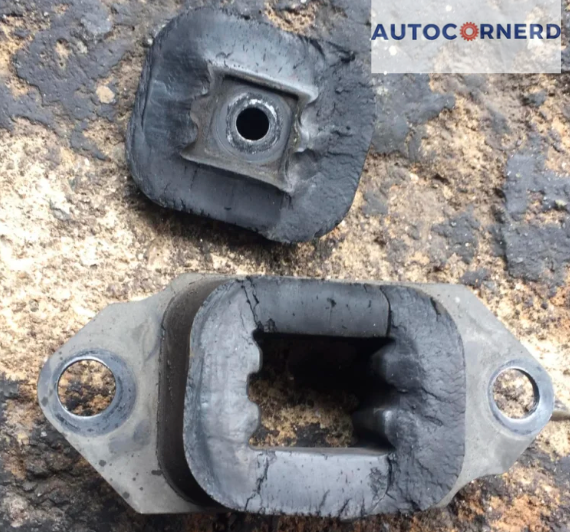
Engine and transmission mounts are responsible for firmly securing these heavy components in place and reducing vibration transferred into the chassis.
The engine is secured by mounts at the top near the front, on the sides, and at the bottom rear. These isolate engine movement and prevent vibration transfer into the chassis:
- Top mounts: Attached at front of engine near radiator support. Restrict vertical and lateral movement. Often most prone to failure.
- Side mounts: Mount engine to subframe or body along the length. Control fore/aft movement.
- Rear mount: Secures rear of engine, often with hydraulic or rubber cushion to allow engine torque reaction. Reduces engine roll.
When mounts become worn out or damaged, it allows excessive movement of the powertrain when idling and accelerating. This can cause noticeable vibration, steering wheel shake, and cabin noise especially when the engine is cold.
Once the engine warms up and the rubber of the mounts becomes more pliable, symptoms may improve or disappear entirely. Moreover, some mounts have gel filling whose dampening ability enhances as the engine warms up.
What are the signs?
Since worn mounts allow more engine movement, testing involves observing engine movement under load:
- Visual inspection: Check for cracked/torn rubber, leaks, looseness. Requires some disassembly.
- Rev test: Have someone rev the engine moderately while watching for excessive rocking/shaking (make sure that parking brakes are applied). Do the same in gear with the parking brake applied to put a load on the engine.
- Pry test: Use pry bar to stress mounts and check for cracks or excessive motion.
How to fix?
Replacing mounts is the only solution. Labor costs vary based on the vehicle and the number of mounts replaced. Expect 1-3 hours of shop time. Use OEM or high-quality aftermarket mounts for longevity.
Perform testing afterwards to verify resolution of vibration issues. Replacing mounts resolves the majority of cold start vibration problems caused by mount deterioration.
2. Thick or Dirty Engine Oil
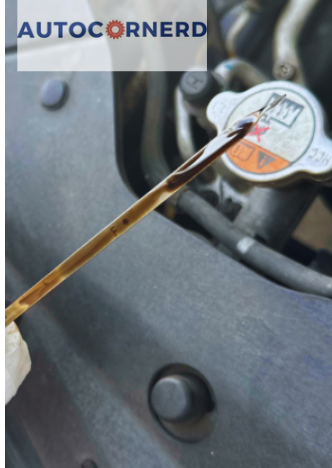
The thickness and condition of oil impacts engine operation, especially on cold starts. Let’s understand how oil flows inside engines and why thick oil causes shaking on startup.
The oil pump circulates oil to lubricate internal parts. An oil pump is driven by engine’s crankshaft. At low rpm, the pump flows less oil. When starting a cold engine, rpms stay low briefly as the engine warms up. So oil flow is initially reduced.
If oil is excessively thick, the pump struggles to push it through the cold engine. This temporarily starves some areas of lubrication, increasing friction and drag in bearings and valvetrain. The extra resistance is felt as shaking or roughness when turning over.
Modern engines often need thinner 0W-20 or 5W-20 oils to flow easily. The lower the number, the less viscous the oil. Using heavier 10W-30 or 15W-40 oils designed for older vehicles will impede flow in newer engines, especially when cold. You can read my guide on SAE 30 vs 10W30 to learn more.
Oils that are too thin can also cause problems, but thick oil is the most common culprit of start-up vibrations and trembling. Always use the manufacturer’s recommended oil viscosity.
Low oil levels can also be an issue:
If your engine is low on oil, the oil pump may not be able to deliver sufficient oil volume or oil pressure at startup.
Bearings rely on that steady oil pressure to keep them separated. Low oil pressure allows extra motion and friction between bearing surfaces, translating into shaking and vibration.
Check your oil level regularly and top off when needed. If your oil level is good, the next thing to check is oil pressure. Low oil pressure may indicate a worn-out oil pump, clogged pickup, or excessive bearing clearances.
Do check your engine oil condition as well:
Over time, oil breaks down and forms deposits, sludge, and varnish. This gunk collects in the engine and sticks to surfaces that need oil flow.
At cold startup, these deposits restrict oil flow even further in combination with the slower oil pump speed. This again increases friction and startup shaking. As the engine warms up, sludge and carbon deposits can burn due to heat, making your drive smoother.
If your oil has reached the recommended oil change interval, this is often the cause of cold start issues. Changing the oil and filter removes most of these deposits. Using a high-quality synthetic oil and shorter change intervals can reduce sludge buildup.
3. Failing Hydraulic Lifters
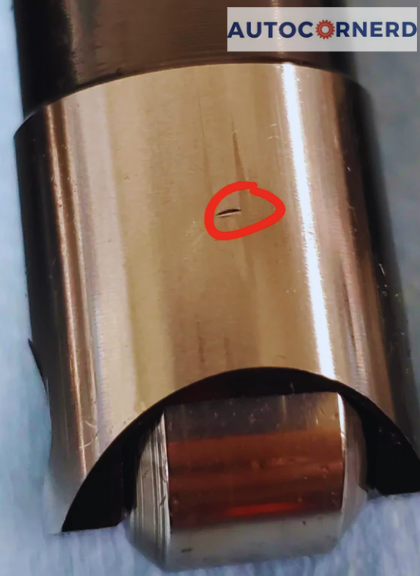
Hydraulic lifters play a critical role in ensuring proper valve train operation in many engines. When they start to fail, it can cause symptoms like hesitation on cold start that go away once the engine warms up. This issue is quite common as lifters wear out over time.
What Hydraulic Lifters Do?
Hydraulic lifters, also called lash adjusters, are small cylindrical components located between the camshaft lobe and valve stem in the valve train assembly. Their job is to maintain zero lash (clearance) in the valve train as the engine heats up and parts expand.
On engines with a camshaft, valve clearances must be adjusted periodically as parts wear and tolerances change over time.
Hydraulic lifters eliminate this maintenance by automatically adjusting clearances. They use engine oil pressure to expand and take up any slack in the valve train.
Inside each lifter is a plunger suspended in oil. As the cam lobe presses down on the lifter, oil pressure pushes the plunger up to maintain contact with the lobe. This compensates for thermal expansion and wear as the engine operates.
To learn more, you can watch the following Youtube Video on working of hydraulic lifters:
How hydraulic lifters can fail?
While very durable, hydraulic lifters can still fail in a few common ways:
- Loss of oil pressure – Without sufficient oil pressure, the lifter cannot maintain its rigidity and pump up. This allows valves to make noise and potentially not open fully.
- Debris ingestion – Dirt inside the lifter can jam the plunger or inlet valve, preventing proper operation.
- Excessive wear – Over time, the lifter bore and plunger will wear and allow oil to leak down. This can cause ticking noises from hydraulic lifters.
- Plunger failure – The internal plunger itself can crack or come apart, destroying the lifter.
How bad failing lifters cause rough idle on cold start?
When cold, engines have greater clearance in the valve train until the oil pressure builds up. Bad lifters that cannot pump up and compensate will exacerbate this.
On start up, the loose clearances combined with low oil viscosity allow the valvetrain to rattle around more violently. This vibrates the engine and chassis.
Once oil pressure builds and the engine reaches operating temperature, clearances tighten up. The lifters also expand with heat and pump up to compensate. This smooths out the vibration and shaking felt on a cold start.
However, the underlying wear is still present and will progressively get worse over time. Even if the shaking disappears when warmed up, bad lifters should be addressed.
How to test?
Using stethoscope or long screwdriver, listen for any ticking noises from the lifter. Worn lifters need to be replaced. They require valve train disassembly for replacement.
To inspect lifters visually, pull the lifters and inspect for cupping or scoring on the roller tip. Another way to check them is rolling the roller tip on your forearm and feeling for an uneven surface.
For a mechanical test, you can push the hydraulic lifter. If it is soft, can be easily pressed with your thumb, and oil also starts leaking through the hole, it means lifter is bad.
4. Malfunctioning Engine Coolant Temperature Sensor
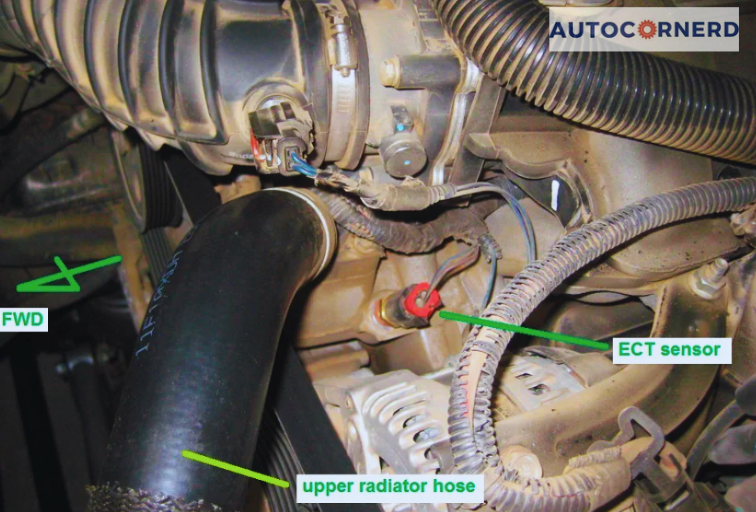
The engine coolant temperature (ECT) sensor is an important helper part for controlling your vehicle’s engine. You can think of it as a little temperature-reading machine that sits inside the stream of liquid coolant, keeping tabs on how hot or cold it is.
The ECT sensor has special electronics inside that change resistance as the temperature changes – more resistance when cold, less when hot. It reports these readings to the vehicle’s onboard computer, known as the ECU.
Using this flow of temperature data, the ECU can make smart decisions about things like:
- How much fuel to mix in with the engine air
- The exact spark timing
- Other important settings
This helps everything run as smooth as possible, whether you just started the engine or it’s warmed up and cruising down the highway.
You’ll usually find the ECT sensor attached snugly into the coolant passage, right around where it flows between the engine and radiator. It’s often mounted near the thermostat housing.
Good to know: Most vehicles actually have two ECT sensors – a primary one that lives closer to the engine cylinder head and does most of the work. When checking your sensor, grab that primary one.
If the ECT sensor gets damaged or worn out, you might notice some weird symptoms like:
- Hard shaking when starting up cold
- Issues that disappear once warmed up
How it can cause problems?
The ECU enriches the mixture at cold start and leans it out as the engine warms up. This improves cold start performance, fuel economy, and emissions.
When the ECT sensor fails or sends incorrect data to the ECU, it can cause:
- Difficulty in cold starting: Without accurate coolant temperature data, the ECU cannot optimize ignition timing and fuel delivery for quick, reliable cold starts. This leads to extended cranking, misfires, stalling, and rough idling when cold.
- Improper ignition timing: Incorrect coolant temperature input will confuse the ECU, leading to premature ignition timing that causes sluggish acceleration and reduced power when cold.
- Hesitation and stumbling: The improper air-fuel mixture from a bad ECT sensor can cause a lean or rich condition, resulting in sporadic hesitation and stumbling issues when accelerating from a stop. This is most noticeable when the engine is cold.
- Check engine light: A faulty ECT sensor may trigger the check engine light and various engine-related error codes due to the ECU detecting abnormal readings.
How to test?
If cold start issues suspect a bad ECT sensor, it can be tested with a digital multimeter. Here is a simple process:
- Locate the ECT sensor and disconnect the electrical connector.
- Set the multimeter to check resistance and connect it to the sensor’s signal and ground terminals.
- Note the ambient temperature of the sensor. Check the resistance reading on the meter and compare to the factory spec chart.
- Warm up the sensor by blowing hot air on it. The resistance should drop as it gets warmer.
- Compare the readings at different temperatures to the spec chart. If they do not align, the ECT is faulty.
5. Poor Fuel Quality
The fuel’s quality that goes into your engine is crucial for smooth performance, especially during cold starts. Bad fuel with impurities can disrupt the combustion process which relies on the precise air-fuel mixture when the engine is cold.
Remember that when cold, the engine needs a rich mixture for ignition. But contaminants in poor quality fuel prevent accurate mixture formation, leading to incomplete combustion. This spotty burn causes uneven engine firing that translates into shakes and vibration during those cold starts.
Defining fuel quality involves two key aspects: octane rating and purity level.
Octane rating indicates how well fuel can withstand knocking or pinging without causing damage.
Using the recommended rating or higher keeps your engine safe based on its design. High performance motors need premium 91+ octane fuels. Forced induction from turbos demands even higher 95+ octane.
Meanwhile, impurities like water, debris or other contaminants disrupt complete combustion, resulting in the vibration. Bad gas stations tend to sell the cheapest but dirtiest quality fuel.
Always consult your owner’s manual for the right octane grade. And try to fill gasoline from reliable stations offering purer fuel for ideal performance. Your engine will thank you with smooth cold starts.
How to prevent that?
If you have left the fuel in your fuel tank for longer, its quality will be affected due to contamination of water vapors and debris in the fuel tank. In that case, you should treat fuel tank with fuel stabilizers to keep it fresh.
Moreover, always re-fill your gas tank from the famous gas station. Seek out top tier brand stations in high traffic areas. Avoid any station that looks dirty, neglected or offers significantly cheaper gas.
6. Corroded Ignition Coils/Spark Plug Wires
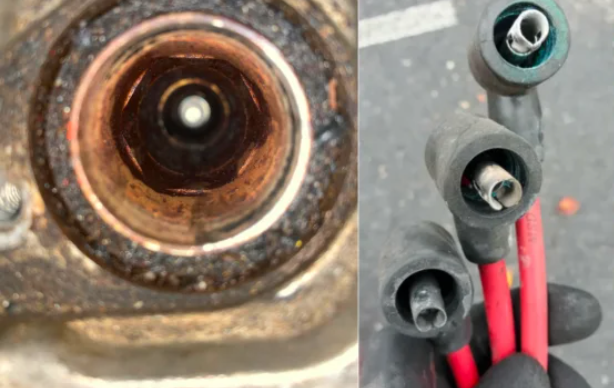
When first starting your car engine on a cold morning, the ignition system components are still cool including the spark plugs, ignition coils and spark plug wires.
The cold temperatures can cause moisture and corrosion buildup on these ignition parts. This buildup makes it more difficult for these components to produce a strong and consistent electrical spark.
Without an adequately strong spark, the air/fuel mixture may fail to ignite properly inside the engine cylinders. This can lead to the engine shaking or misfiring when initially started cold until it warms up and the moisture evaporates.
The ignition coils especially have to work much harder to be able to fire the spark plugs effectively when the system is still cold. If the ignition coils or spark plug wires are already worn or damaged, they may struggle even more to deliver a steady spark when cold. This could result in one or more engine cylinders misfiring.
Damaged or worn ignition coils/wires often set off an engine trouble code for a cylinder misfire – P030X. While the engine is still cold, this misfire may cause noticeable shaking. As the engine completely warms up and the ignition components start operating at peak efficiency, the misfiring and shaking may disappear.
Depending on make and model of your vehicle, it ignition coils have two types:
- COP (Coil over plugs)
- Coil packs (these have spark plug wires)
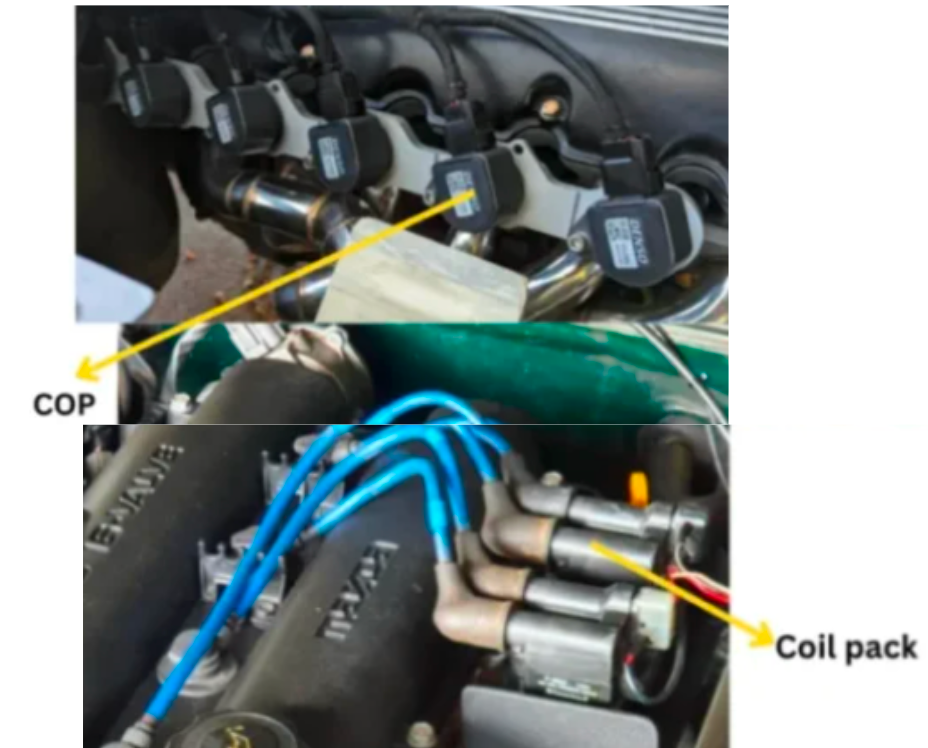
How to test?
A successful approach for COP ignition systems involves exchanging the ignition coil of the problem cylinder with an ignition coil from another cylinder. Subsequently, monitor whether there is any alteration in the trouble code. If a change occurs, it suggests a defective ignition coil.
For ignition coil packs/spark plug wires, you can watch following video:
7. Fouled Spark Plugs
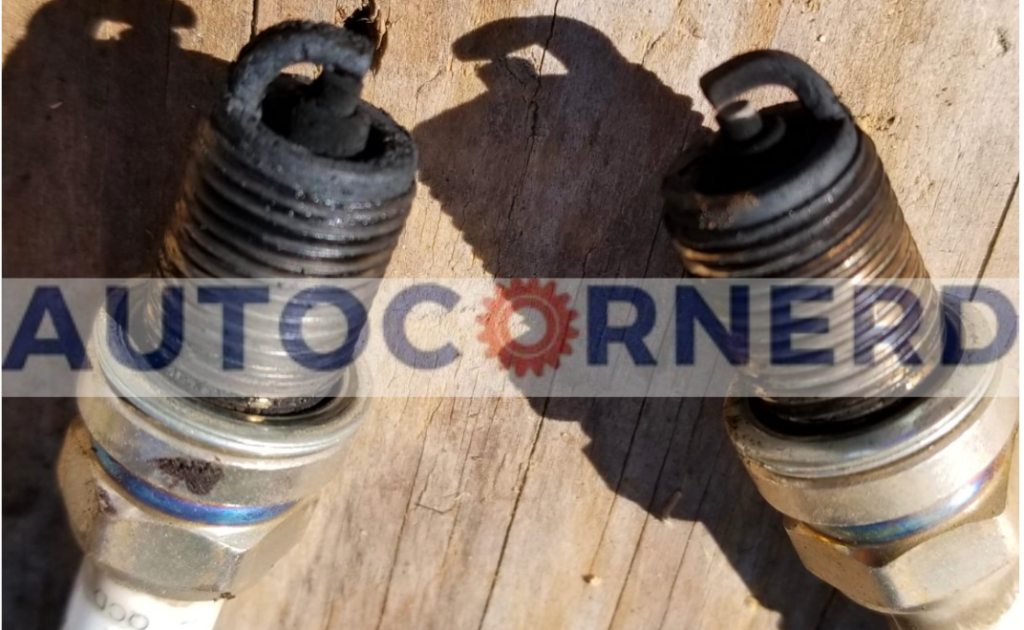
Just like with an ignition coil, moisture and corrosion can sneak their way onto spark plugs. When an engine is cold, the moisture makes it tougher for the plugs to generate a robust spark capable of igniting the fuel mixture.
Without steady sparking, the air-fuel blend in one or more cylinders may fail to ignite correctly. This can lead the engine to misfire and tremble at cold start.
How Do Spark Plugs Get Contaminated?
Spark plugs can become tainted from normal engine operation. Some ordinary ways include:
- Over time, carbon and fuel deposits accumulate on the electrodes and insulator, preventing the plugs from sparking properly.
- Oil seeping into the cylinders can also dirty the plugs, resulting in a faint spark or no spark at all. Excess oil, worn piston rings, leaking seals, and short trips can all help oil fouling gather on the plugs.
How to diagnose?
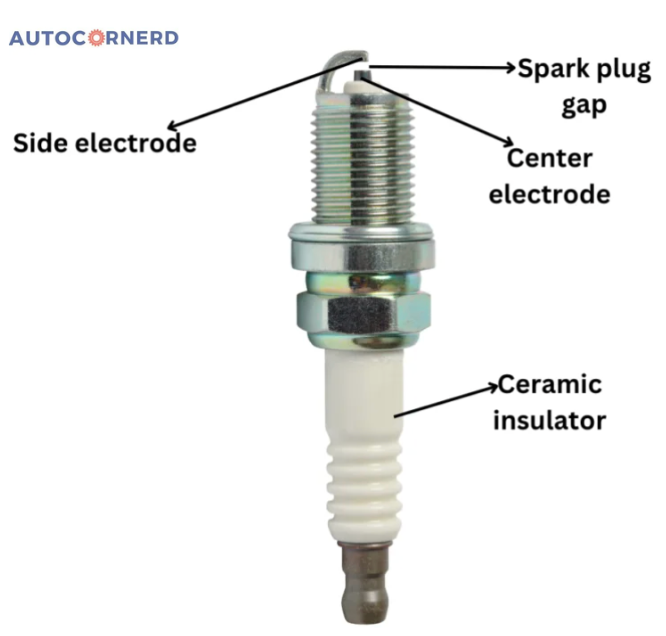
Visual inspection of the spark plugs can indicate bad plugs. Look for wet oily deposits, excessive carbon build up, electrode wear, or light grey ash deposits.
You can test spark plugs by using a multimeter and setting it to resistance measurement. You should get a reading between 4,000 to 8,000 ohms on the center electrode.
In addition, you should look for a short between the ground and center electrode of the spark plug. No short means a good spark plug.
You can watch following youtube video to learn more:
How to fix?
You can try cleaning the spark plugs using the wire brush and spark plug cleaner to carefully remove any carbon deposits or contaminants from the electrode. Ensure not to damage the electrode or insulator in the process.
First, use compressed air to clean off any dirt and debris. Then, keep the spark plug soaked in the brake cleaner till all the gunk on the spark plug is washed away.
8. Clogged Fuel Injectors Due to Carbon Buildup
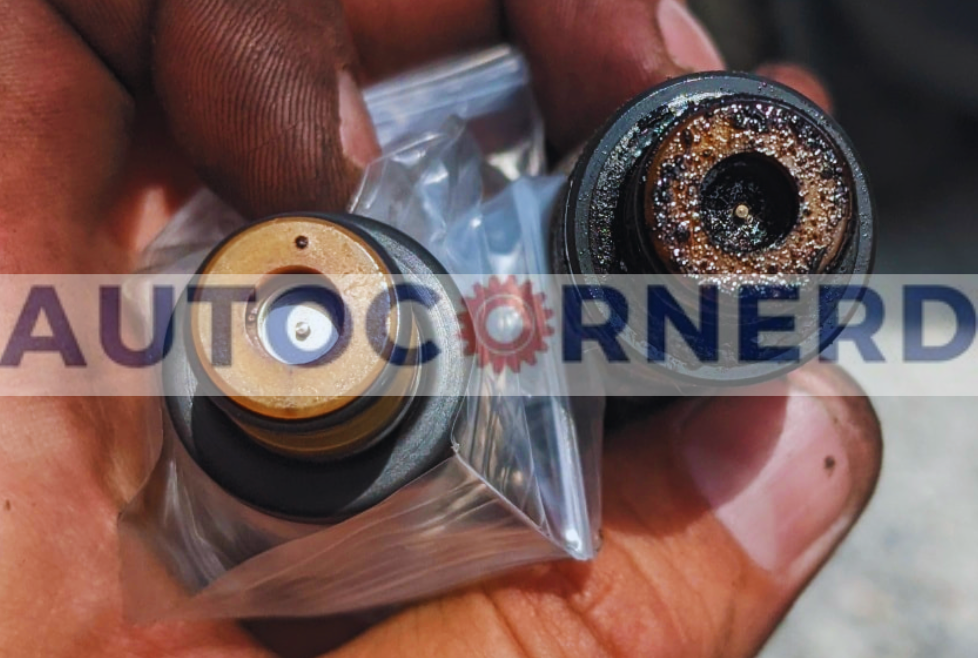
The fuel injectors receive pressurized fuel from the pump and utilize a coil functioning as an electromagnet.
When the engine control module transmits voltage to the injector coil, the resultant magnetic field acts to raise the valve, enabling fuel to spray through the nozzle. The injector cycles on and off rapidly to regulate fuel quantity.
Effective fuel injection facilitates an optimal air-fuel ratio for clean, efficient combustion in all engine conditions. If accumulations or damage obstruct the injectors, fuel atomization and delivery become impaired, causing driveability problems.
Why Fuel Injectors Get Clogged?
Injector clogging commonly arises from a few key factors:
- Carbon Buildup: Combustion residues and fuel deposits can bake onto injector tips.
- Contaminated Fuel: Sediment and particles may partially obstruct nozzle holes.
- Worn Components: Compromises atomization and spray pattern.
Cold engines accentuate these issues since the fuel does not atomize as effectively. Clogged injectors intensify fuel delivery problems when the system already struggles to spray.
How to test?
First, you should perform visual inspection of fuel injectors as follows:
- Remove injectors and inspect nozzle ends and inlet screens for carbon deposits or corrosion. Clean if necessary.
- Check for cracks or damage around injector bodies and insulators.
- Ensure electrical connectors are tight and pins are not corroded.
You can check for damage by looking at the two terminals of the injector. These are the ends of the magnetic coil that carry electricity.

You should also check the o-ring of the fuel injectors. It is a small ring that prevents fuel from leaking. If it’s damaged, you’ll need to replace it. You can push the o-ring with your hand until it fits securely.
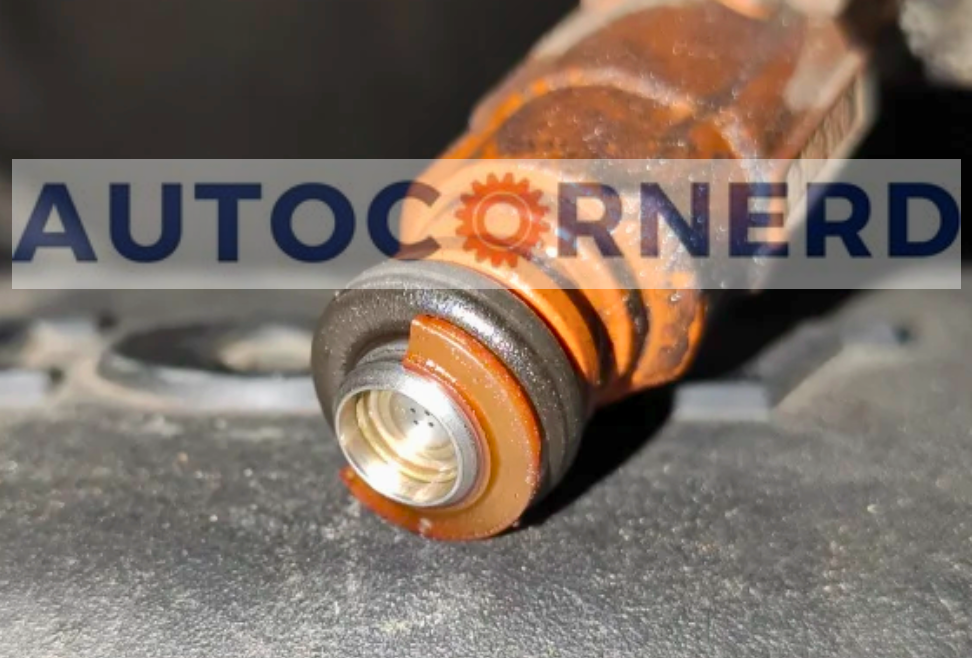
How to test?
To test if a fuel injector is bad, you can use a multimeter. Connect the probes to the terminals of the injector and set the multimeter to the right Ohms value (usually around 30 Ohms).
If the resistance shows “infinite,” it means the coil is open. If it shows “OL” or very low resistance, it means the coil has short-circuited. The right resistance means the coil is okay.
Another fuel injector tests include following:
- Fuel spray direction
- Fuel injector clicking sound
With the fuel pump running, pressurize the fuel rail and check each injector nozzle tip for a solid conical spray pattern without any interruptions.
Another test is to listen for a clicking noise. Use a long screwdriver near the injector and turn the key to prime the fuel pump. Then connect a 9V or 12V battery to each injector and listen for a ticking noise. That’s the sound of the injector opening and closing.
If you want a visual guide on how to test fuel injectors, check out a video starting from 2:40.
9. Vacuum Leaks
Unlike several engine issues like failed ignition or fuel delivery causing constant symptoms, vacuum leaks frequently cause drivability problems only under specific conditions.
A repeated vacuum leak pattern exists where engines run rough during cold startup then smooth out once warmed up.
The reasoning for this performance lies in comprehending how engines utilize vacuum and how leaks disrupt normal function.
How do vacuum leaks happen?
First, understanding engine vacuum and operation is required to grasp vacuum leaks. Engine vacuum refers to the negative air pressure generated in the intake manifold when pistons move down on the intake stroke.
As pistons pull down, they suck air through the intake valves into the cylinders thus creating low pressure in the intake manifold. More incoming air from opened throttles causes vacuum drops.
Where Can Vacuum Leaks Occur?
Various vacuum leak locations exist including:
- Vacuum hoses: Rubber hoses grow brittle and cracked over time enabling vacuum leaks. The PCV and brake booster hoses frequently source leaks.
- Intake manifold gaskets: Gaskets sealing the intake manifold to cylinder heads endure engine heat warping or leaking over time.
- EGR valves: The EGR valve recycles some exhaust gases into the intake. Leaks happen past its gasket or component failures internally.
- Throttle body: The throttle body to intake manifold gasket surface can warp and leak vacuum.
- PCV valve and breather system: The PCV valve and hoses vent blowby gases. Leaks here expose the intake to oil vapor and unmetered air.
Why Do Vacuum Leaks Cause a Cold Start Shake?
So why do vacuum leaks seem to cause issues on cold start but not when warmed up? The answer lies in how the engine computer manages fuel trims.
At cold start, the engine computer uses pre-programmed baseline fuel maps to provide the proper air/fuel mixture for starting and warm-up.
Once the engine warms up to normal operating temperature, the computer switches to using feedback from the oxygen sensors to trim fuel delivery and maintain the ideal 14.7:1 air/fuel ratio.
A vacuum leak introduces unmetered, extra air into the intake that the computer does not account for when using its baseline fuel maps on a cold start. This makes the engine run lean and jerk until it warms up.
Once warmed up, the oxygen sensor feedback allows the computer to adjust for the extra air by adding more fuel to compensate. This provides the proper air/fuel mix and the engine runs smoothly again.
How to detect?
While the engine is running, listen closely for any hissing sounds. A vacuum leak often makes a distinct high-pitched hissing noise. If you hear it, try to locate the source, as it can help you find the problem area.
Professionals sometimes use smoke machines to find vacuum leaks. These machines fill the intake system with smoke, making it easier to see where the smoke escapes from. While this method might not be readily available for most people, it’s highly effective in finding even the trickiest leaks.
You can also use carb cleaner to detect vacuum leaks.
10. Dirty and Thick Transmission Fluid
The transmission fluid is the lifeblood of your automatic transmission. When it gets dirty or thickens over time, your transmission suffers. Your gear shifts become stiff and jerky, especially when cold.
To understand why, we must understand how transmission fluid works. This transmission fluid has crucial jobs:
- It generates the hydraulic pressure to smoothly engage clutches and bands to shift gears. The transmission pump pressurizes the fluid to make parts slide and connect.
- It lubricates internal components like shafts, gears, bearings, and seals so they don’t overheat or wear out too fast. The fluid coats and cushions these intricate parts.
- Inside the torque converter, it transmits engine power to move the vehicle. The fluid couples the engine output to the transmission input.
- It acts as a coolant by absorbing heat from friction then dissipating it through the transmission cooler. Less heat means longer transmission life.
Do you know your car may not even shift into any gear if transmission fluid gets dirty? You can read my guide on that topic to learn more.
How it causes problem?
When transmission fluid is thick and dirty, it cannot flow quickly through tiny passageways in the valve body or torque converter. The results are delayed engagement of gears and hard, jarring shifts.
Engine deposits, corrosion and different chemical reactions in transmission fluid while flowing through the transmission can affect its viscosity. That effect is more pronounced at lower temperatures.
You can also read my guide on transmission shifting hard when cold to learn more.
How do I spot?
- Dark/black color instead of red
- Burned or rancid smell
- Positive particle count on magnets inside transmission pan
- Sludge formation
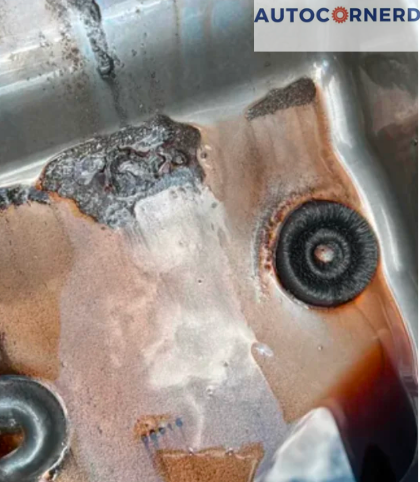
In those cases, I would highly recommend you to perform a full transmission flush.
11. Dirty Engine Air Filter

As the engine draws in air, it passes through the air filter first to remove any contaminants. A clean, unclogged filter allows maximum airflow to the engine for optimal combustion and performance. Over time, the filter collects more and more gunk and gradually restricts airflow.
On cold startup, the air density is greater and the air alone has more difficulty passing through a severely clogged filter. The restricted cold air flow reduces the proper air-fuel ratio.
Once the engine reaches operating temperature, two things happen – the incoming air thins out as density decreases, and any moisture trapped in the filter has a chance to evaporate.
This combination allows improved airflow to smooth out engine operation. Of course, performance is still down due to the overall reduced airflow from dirt buildup.
How to inspect?
Here are some tips for checking your engine air filter:
- Remove the housing and take out the filter for visual inspection
- Look for very dark or black sections, which indicate dirt buildup
- Check for holes, cracks or tears in the filter material
Compare it to a new filter if unsure. The used one should not appear overly dirty or restrictive.
How to fix?
If the air filter is only slightly dirty, it can be cleaned using compressed air. Gently blow compressed air from the clean side of the filter, forcing the dirt and debris out through the dirty side.
If the air filter is heavily soiled or shows signs of damage, it is recommended to replace it. Regularly replacing the engine air filter ensures optimal airflow to the engine and helps maintain its performance.
The frequency of replacement may vary depending on the type of filter used. For OEM (original equipment manufacturer) filters, it is generally advised to replace them every 15,000 miles. However, if you are using a cheaper aftermarket filter, more frequent replacement, such as every 5,000 miles, may be necessary.
12. Clogged Fuel Filter
On cold start, the engine requires extra fuel to idle smoothly and accelerate. This is because the cold engine and components require more fuel to get moving and warming up.
The fuel injectors have to work harder, the ignition system needs higher energy sparks, and piston rings don’t seal as well until expanded from heat.
All of this leads to an increased fuel demand until the engine reaches normal operating temperature.
The viscosity or thickness of fuel increases at colder temperatures. Thicker and more viscous fuel doesn’t flow as easily through the fuel lines and filter.
This is especially true once the filter has accumulated some debris and is already partially clogged.
At the same time, cold temperatures cause condensation in the air which can collect in the gas tank and contaminate the fuel with water.
The combined effects of the thicker fuel and condensation make it even harder for fuel to pass through a clogged filter when cold.
Without enough fuel present, the combustion events are weak, uneven, and can misfire. This leads to rough idling and sputtering as the engine speed surges up and down from the weak combustion events.
As the engine warms up and expands, the fuel viscosity decreases, providing better flow. The engine also needs less fuel overall when warm, so the restricted flow becomes adequate. This allows smooth running once at operating temperature despite the clogged fuel filter.
How to fix?
Replacing a contaminated fuel filter with a new one is the solution for cold start sputtering in this case. The fresh filter will allow proper fuel flow even in cold weather.
For preventative maintenance, most manufacturers recommend replacing the filter every 60,000 to 80,000 miles or according to the maintenance schedule.
13. Clogged EGR Valve
The EGR valve opens to allow exhaust gases to enter the intake manifold and mix with the incoming air/fuel mixture.
It is controlled either electronically or by vacuum and normally only opens under light engine loads and speeds.
When open, the recirculated exhaust helps cool the combustion process, which in turn lowers cylinder temperatures and the formation of NOx.
On many modern engines, the EGR valve is closed by the engine computer during cold starts. This helps the engine warm up faster by allowing normal combustion temperatures.
Once warm, the EGR opens to do its job of reducing NOx emissions. When EGR opens, exhaust gases take place of fresh air with high oxygen content. This reduces combustion temperature, resulting in lesser NOx emissions.
However, with the EGR stuck open during a cold start, the combustion temperature is cooled significantly by the exhaust gases. This prevents engine warm up and causes your car to tremble on cold startup.
How to test?
If your EGR valve is malfunctioning, the OBDII scan tool will display P0400, P0401 or P0402 error codes.
Now, remove the EGR valve and perform a visual inspection to check for any cracks or holes in the housing. A cracked or damaged EGR valve will need to be replaced.
To check if the EGR valve is working correctly, we will now use a hand-operated vacuum pump.
If the EGR valve can hold a vacuum, it indicates that the valve is functioning properly. However, if the vacuum pressure drops off after a while, it suggests a faulty EGR valve that needs to be replaced.
14. Bad Battery
Battery is being charged by the alternator when engine is running. If you are starting your car after a very long time and temperature is cold. The chances are that battery has been drained out, and is unable to provide sufficient power.
In that case, on cold startup, you should check your battery voltage. The voltage across battery terminals should be between 13.5 and 14.2 while the engine is running at idle and the lights are off.
Final Thoughts
A shaking car that runs smooth once warm can leave drivers puzzled. But don’t let the disappearing trick fool you – several sneaky culprits could be hiding under the hood.
Worn engine mounts allow too much unwanted movement. Thick, sluggish oil when cold resists flowing freely to lubricate and protect. Hydraulic lifters failing to pump up prevent valves from opening and closing properly.
Unhappy sensors feed confused signals. Sparks misfiring instead of firing crisp and clean. Fuel and air restricted from entering cylinders. Vacuum leaks sucking in excess outside air. Transmission fluid too thin or thick to transfer power smoothly.
Any of these conditions can set your engine shimmying when first starting up. The common thread? Symptoms fading away once optimum operating temperature is reached. For worn mounts and lifters, heat expands and softens materials, lessening slop and stiffness. Warmer oil flows slick as butter. Parts expand, sensors calibrate, leaks often seal. Like magic, the vibration vanishes.
But make no mistake – allowing these problems to continue unchecked accelerates wear and tear exponentially over time. The temporary warm-up truce merely masks the ceaseless grinding down of critical components and connections. Proper maintenance now prevents catastrophic engine failure down the road.

